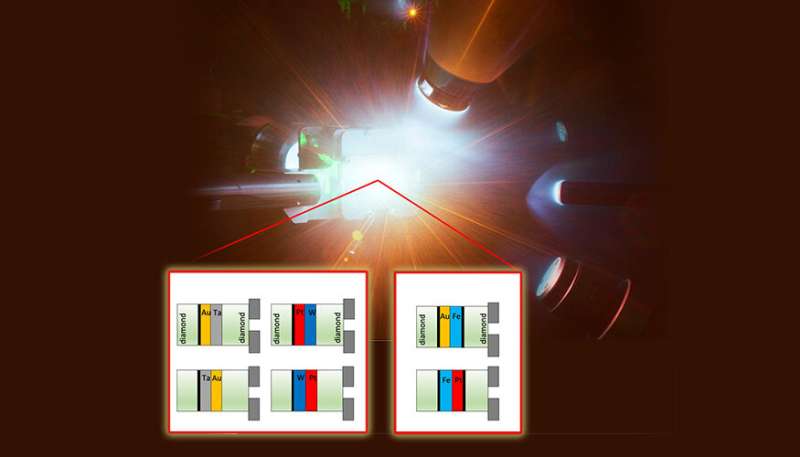Improving precision of pressure determination in nanosecond X-ray diffraction experiments

X-ray diffraction measurements under laser-driven dynamic compression allow researchers to investigate the atomic structure of matter at hundreds of thousands of atmospheres of pressure and temperatures of thousands of degrees, with broad implications for condensed matter physics, planetary science and astronomy.
Pressure determination in these experiments often relies on velocimetry measurements coupled with modeling that requires accurate knowledge of the optical and thermomechanical properties of a window material, resulting in significant systematic uncertainty.
In new research published in Physical Review B, Lawrence Livermore National Laboratory (LLNL) scientists report on a series of X-ray diffraction experiments on five metals dynamically compressed to 600 GPa (6,000,000 atmospheres of pressure). In addition to collecting atomic structure information for multiple compressed samples, the team demonstrated a different approach for pressure determination applicable to X-ray diffraction experiments under quasi-isentropic ramp compression.
"Ultimately this will improve our understanding of material properties under extreme conditions of pressure and temperature, a strategic area of research at the Laboratory," said LLNL physicist Federica Coppari, lead author of the study.
In recent years, there has been a widespread surge in the use of dynamic compression to generate extreme conditions of pressure and temperature in the laboratory. Combined with X-ray diffraction measurements, these experiments have enabled unprecedented discoveries with far-reaching implications for planetary science and condensed matter physics. Examples include the long-predicted solid-solid phase transition in magnesium oxide and iron oxide, the existence of the exotic superionic phase of warm dense water ice and the exceptional stability of FC8 diamond up to 2 TPa pressure. In material science, these experiments have been used to document the melting of tantalum at extreme conditions and to characterize the high pressure/high temperature phase transitions in gold.
In the new work, LLNL scientists and collaborators tested the use of in-situ calibrants as a novel approach to pressure determination in X-ray diffraction experiments under dynamic compression. Similarly to the approach used in high-pressure X-ray diffraction measurements with diamond anvil cells, this method relies on using materials whose pressure-density equation of state is well known as pressure gauges.
"By collecting their diffraction patterns in addition to that of the sample under study, one can determine the density and infer the pressure applied to the sample using the previously determined pressure-density relationship," Coppari said.
Multiple materials (a combination of platinum, tantalum, gold, tungsten and iron) were simultaneously compressed along a quasi-isentropic path to pressures of several hundred GPa (several millions atmosphere) at the Omega Laser Facility at the University of Rochester. The collection of X-ray diffraction patterns from the calibrant and of simultaneous velocimetry measurements allowed the team to not only cross-validate the two methods for pressure determination, but also to establish the use of in-situ calibrants as a viable alternative to Velocity Interferometer System for Any Reflector (VISAR) measurements in dynamic ramp-compression experiments.
In addition to providing a new capability that improves the precision of the pressure determination by a factor of four, this work validates a method that has been widely employed in past dynamic compression experiments, which will contribute to reduce the gap between dynamic and static compression experiments.
Other LLNL authors include Dayne Fratanduono, Marius Millot, Richard Kraus, Amy Lazicki, Ray Smith and Jon Eggert as well as researchers from the Laboratory for Laser Energetics at the University of Rochester. This project also benefited from the contribution of Eric Folsom, Renee Posadas and Russell Wallace, who assisted with target assembly and metrology.
More information: F. Coppari et al, X-ray diffraction measurements and pressure determination in nanosecond compression of solids up to 600 GPa, Physical Review B (2022). DOI: 10.1103/PhysRevB.106.134105
Journal information: Physical Review B
Provided by Lawrence Livermore National Laboratory





















